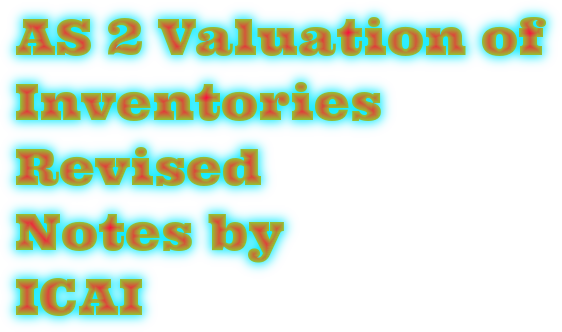This valuation part of inventory is very important as it affects both revenue of the business and the asset. Because if valuation will be done at higher than actual, it will be shown in the trading account as closing stock and resulting in to increase in gross profit and the same value will also be shown in the balance sheet as current asset so it will increase value of asset.

Definition of Inventory AS 2 As per the definition of inventory or closing stock it includes following things; Items which are held for sale in the normal course of business that is finished stock of goods. Work-in-progress (WIP) for such sale.
Goods which are not yet finished or ready to sale. Raw material which is not even issued for production while valuation of closing stock or inventory. It also includes consumable stores item. Applicability AS 2 AS-2 is not applicable to following cases.
Work in process in the construction contract business including, directly related to service contract. Any financial instruments held as stock in trade which includes shares, debentures, bonds etc.
Other inventories like livestock, agricultural product and forest product, natural gases and mineral oils etc.
Work in progress in the business of banking, consulting and service business. That means it includes incomplete consulting service, merchant banking service and medical service in process.
All of above are not cover under the definition of inventory/ closing stock that’s why this accounting standard if not become applicable to above cases or in the course of business.
Purchase cost :
Invoice price at which goods are purchased Duties and taxes paid Freight inward Any other expenditure directly relating to acquiring goods Above cost should be reduced by following Duties and taxes received or receivable back from the tax authority Trade discount Rebate Duty drawback Download : AS 2 Valuation of Inventory Quick Revision Notes Cost of conversion As per AS 2 After purchasing the raw material or goods during the production time whatever cost is paid or payable will be considered as conversion cost.
It includes direct labour, material and other direct expense plus allocation of fixed and variable production overhead incurred for conversion or raw material in to finished goods. Following things should be considered for conversion cost of the inventory.
1. Fixed production overhead – it includes indirect cost for production which remains constant without relating to numbers of units produced. For example – depreciation and maintenance of factory building.
2. Variable overhead – indirect cost of production which depends on the number of units are produced such as packing material and other supporting material to finished product.
3. Allocation of fixed expense should be made on the bases of normal capacity and allocation of variable cost will be done on the basis of actual numbers of units are produced. Other cost It includes any other expenditure incurred to bring inventory or stock in the present location and condition.
All three are the major part of the cost which required to be considered for valuation of the inventory. But it should not include abnormal wastage relating to material and labour, storage cost, administrative expenses & selling and distribution expenses.
Methods of valuation of inventory as per AS 2 There are numbers of method for valuation of the inventory in the normal course of business which includes FIFO, LIFO, weighted average cost, standard cost and retail method.
But practically following two methods only used as per AS 2.
FIFO (first in first out) Weighted average Net realisable value As per AS 2 Net realisable value means normal selling price of the goods less estimated expenditure to sale such goods. It is estimated value on the basis of reliable evidence at time of valuation.
Estimation of net realisable value can be done on the following basis.
If the finished goods in which raw material and supply is used is sold at cost or above the cost, then the estimated realisable value of raw material and supplies is considered more than cost.
It the finished goods in which raw material and supply are used is sold at below cost then the estimated realisable value of raw material or supply is equal to replacement price of raw material or supply.
Disclosure in financial statement AS 2 Valuation of inventory is made on comparison of cost and net realisable value whichever is lower.
This value should be disclosed in the financial statements.
Other things relating to inventory to be disclosed in accordance with Accounting Standard-1 are accounting policies adopted in measuring inventory, cost formula and classification of inventory such as finished goods, raw material & WIP and stores and spares etc.